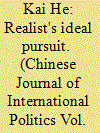| Srl | Item |
| 1 |
ID:
114900


|
|
|
|
|
| Publication |
2012.
|
| Summary/Abstract |
Shortly after US President Obama and Australian Prime Minister Julia
Gillard sealed the bilateral defense deal in November 2011 under which
2500 US marines will be stationed in Australia came Obama's announcement on January 5 2012 of the new strategic defense guidance entitled
Sustaining U.S. Global Leadership: Priorities for the 21
st
Century Defence.
The document claims that China's rise might have impact on the US economy and security, and that countries such as China and Iran continue to
pursue asymmetric means of countering US power projection capabilities.
1
Both the Chinese Ministry of Foreign Affairs and the Ministry of Defense
refuted these claims, arguing that not a shred of evidence exists to support
such wild accusations.
2
Many media reports nevertheless argue that competition between the United States and China amounts to a new Cold War.
|
|
|
|
|
|
|
|
|
|
|
|
|
|
|
|
| 2 |
ID:
114901


|
|
|
|
|
| Publication |
2012.
|
| Summary/Abstract |
Much has been written about China's rise, yet from a historical perspective,
China's rise is nothing new. Historian Wang Gungwu points out three past
instances: the Qin-Han unification, the Sui-Tang reunification, and the
Ming-Qing dynasties. The present, fourth rise of China 'needs to be seen
in a longer perspective'.
1
What can we learn from China's rich historical
experience? The polity that we now know as China was the most powerful
state and a regional hegemon during certain periods of East Asian history.
How did China behave in the region when it had preponderant power? Did
China expand when strong? And how did China manage its hegemony to
stay on top? As the Ming dynasty (1368-1644) is the only period from the
fall of the Tang dynasty in 907 until the end of the Qing dynasty in 1912
when a native or non-alien Chinese dynasty dominated East Asia, this feature alone makes the Ming dynasty a good vehicle for examining Chinese
strategic behaviour. By examining a past regional hegemon, this article
offers a first-cut at the longer historical perspective on the rise of China.
|
|
|
|
|
|
|
|
|
|
|
|
|
|
|
|
| 3 |
ID:
114903


|
|
|
|
|
| Publication |
2012.
|
| Summary/Abstract |
It is no exaggeration to say that Yan Xuetong's Ancient Chinese Thought,
Modern Chinese Power is a path-breaking project that integrates ancient
Chinese philosophy, Pre-Qin history, and contemporary International
Relations (IR) theory. Although Yan has not introduced a new grand
theory of IR in the book per se, he has paved a fresh theoretical and intellectual path to reforming current, western-philosophy-and-history-based IR
theory. If scholars follow Yan's guidance and approach as laid out in the
book, it will be no surprise to see developed more than one new IR theory.
|
|
|
|
|
|
|
|
|
|
|
|
|
|
|
|
| 4 |
ID:
114902


|
|
|
|
|
| Publication |
2012.
|
| Summary/Abstract |
Dr. Zhou Fangyin's 'Equilibrium Analysis of the Tributary System' enriches
the increasingly salient debate among Chinese International Relations (IR)
students on the so-called 'tributary system'
1
in three ways. First, it correctly
points out that China did not unilaterally create the mode of interstate
connections in pre-modern East Asia. Rather, the 'system', if there was
indeed such a thing, was an institutional mechanism mutually constructed
by both the central and peripheral regimes. This, in my opinion, is a crucial
clarification that revises the views of some of the Fairbankian School of
scholars, who insist that the tributary system was an institution enforced
by China on surrounding states that only passively accepted it.
2
Second, the
article differentiates between tributary discourse and practice, and emphasizes the system's internal logic in practical policy making. In another words,
by observing the tributary system as policy-oriented behaviour, the article
rejects the explanation of it as a (partially self-deceived) cultural phenomenon, instead emphasizing its realist significance as a rational political
arrangement. In so doing, it opens the way to further research on the
topic along the political science line.
|
|
|
|
|
|
|
|
|
|
|
|
|
|
|
|